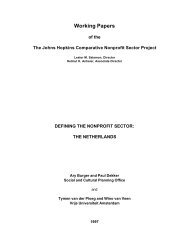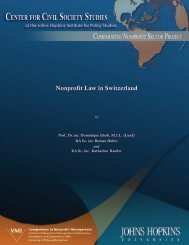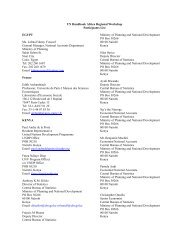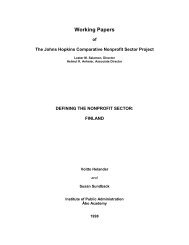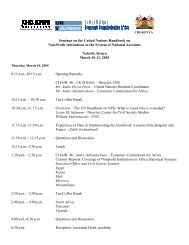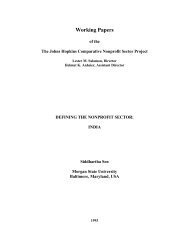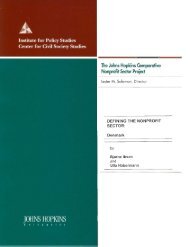Campetella, González Bombal, and Roitter<strong>Defining</strong> <strong>the</strong> <strong>Nonprofit</strong> <strong>Sector</strong>: <strong>Argentina</strong>While <strong>the</strong> law grants tax exemption to nonprofit organizations, <strong>the</strong> national tax bureau(Dirección General Impositiva or DGI) is in charge of ascertaining that <strong>the</strong>se requirements areproperly fulfilled. Consequently, <strong>the</strong> granting of <strong>the</strong> tax exemption by law is not permanent, but itexpires as soon as <strong>the</strong> DGI finds any anomaly or violation of <strong>the</strong> established legal conditions.From <strong>the</strong> “social definition” perspective, <strong>the</strong> term civil association covers a wide range oforganizations, which can be grouped as follows:Cooperators. This term refers to institutions organized by clients of hospitals and schools in order tocontribute to <strong>the</strong>ir maintenance and activities. They organize fund-raising activities, such as raffles,sale of “contribution certificates,” and voluntary contributions. They also are granted state subsidiesand manage <strong>the</strong> provision of public services, such as <strong>the</strong> case of parent-teacher cooperators throughwhich <strong>the</strong> state distributes meals for primary school pupils. Cooperators are defined legally asassociations in <strong>the</strong> broad sense, and <strong>the</strong>refore <strong>the</strong> General Justice Inspection regulates <strong>the</strong>m. In <strong>the</strong>case of parent-teacher cooperators, <strong>the</strong>y are also registered in and controlled by o<strong>the</strong>r local regulatoryagencies –e.g., in <strong>the</strong> Federal District, <strong>the</strong> General Bureau of Parent-Teacher Cooperators.Cooperators are usually created within public institutions –such as schools or hospitals– and receivepublic subsidies. Thus, <strong>the</strong>y maintain a close relation with <strong>the</strong> state, complementing its socialfunctions and are crucial for <strong>the</strong> better provision of public health and education functions.Immigrant-based organizations. These organizations have played a critical role in <strong>the</strong> constitutionof Argentine nonprofit sector, owing to <strong>the</strong> strong influence of immigration in <strong>the</strong> building ofArgentine society. Most associations stem from <strong>the</strong> immigration waves that reached <strong>Argentina</strong> at <strong>the</strong>turn of <strong>the</strong> 20 th century, mainly composed by Italians and Spaniards, but also by Jewish, French,German, Armenian, and o<strong>the</strong>r Western European immigrants. The majority of <strong>the</strong>se associations arelegally civil associations or mutual benefit associations, and <strong>the</strong>y undertake cultural, sports, social,and charitable activities. It should also be mentioned that <strong>the</strong> hospitals created by <strong>the</strong>se immigrantbasedorganizations –mainly originated as health clinics– have become important institutions thatnowadays provide high quality services without distinguishing national origins.Neighborhood associations. The origins of <strong>the</strong>se societies can be traced back to <strong>the</strong> 1920s withurban expansion and suburban development. In this context, neighborhood associations emerged toprovide basic needs such as utilities –electric power, gas, water, etc.– or to create spaces for sociallife and education. They currently carry out several activities, e.g., demands to <strong>the</strong> government for<strong>the</strong> improvement of urban infrastructure; establishment of artistic or educational workshops;organization of sports or recreational events, etc. Neighborhood associations are legally defined ascivil associations in <strong>the</strong> broad sense, and <strong>the</strong>refore <strong>the</strong> General Justice Inspection controls <strong>the</strong>m at <strong>the</strong>national level. However, as <strong>the</strong>y are linked to <strong>the</strong> corresponding neighborhood, <strong>the</strong>y are also subjectto municipal legislation, as established by <strong>the</strong> Organic Law of Municipalities. 15 Hence, <strong>the</strong>corresponding municipality authorizes each neighborhood organization to act in a geographicallylimited area, and delegates to <strong>the</strong>m a wide range of functions. On <strong>the</strong> o<strong>the</strong>r hand, as eachmunicipality determines its own regulations, <strong>the</strong>re is no general law for neighborhood associations.These organizations maintain a close relationship with <strong>the</strong> state, and <strong>the</strong>y remain as <strong>the</strong> main15This law was enacted in 1958 and updated in 1982.11
Campetella, González Bombal, and Roitter<strong>Defining</strong> <strong>the</strong> <strong>Nonprofit</strong> <strong>Sector</strong>: <strong>Argentina</strong>connection between <strong>the</strong> state and <strong>the</strong> community. From this perspective, it is common to refer to<strong>the</strong>m as intermediate entities or community organizations.Popular libraries. Their origin, as in <strong>the</strong> case of neighborhood associations, can be traced back to<strong>the</strong> 1920s and is related to urban development. They are usually created within public schools orneighborhood organizations. They are regulated by <strong>the</strong> National Bureau for <strong>the</strong> Protection ofPopular Libraries, which has a special fund granted by law and composed of a percentage of <strong>the</strong>income of gambling games, excluding horse races. As in <strong>the</strong> case of cooperators, popular librarieshave a complementary-subsidiary relation with <strong>the</strong> state.National academies and research centers. These terms refer to private, independent institutions,whose legal status is usually that of civil association, engaged in <strong>the</strong> study and research of science,literature and art. National academies are older and cover a broader range of topics. Researchcenters are usually formed by social scientists, and <strong>the</strong>y emerged in <strong>the</strong> 1960s, <strong>the</strong> majority of <strong>the</strong>msupported by international cooperation. Their creation and development was closely linked to <strong>the</strong>political situation of <strong>the</strong> time. Thus, for example, <strong>the</strong> state’s intervention in <strong>the</strong> public university in1966 made <strong>the</strong>se centers important places for debate and refuge for expelled professors. Again in <strong>the</strong>1970s <strong>the</strong> centers expanded, and from 1976, <strong>the</strong> expulsion of academics for political reasons and <strong>the</strong>military dictatorship’s widespread repression turned <strong>the</strong>se centers into crucial havens for academics.Since <strong>the</strong> re-establishment of democracy in <strong>the</strong> 1980s, <strong>the</strong>se centers have played an important role in<strong>the</strong> debate on social problems. Apart from research, <strong>the</strong>y engage in consulting, teaching andadvocacy. For <strong>the</strong> state, some of <strong>the</strong>se centers now constitute sources for recruiting andcollaboration.Non-governmental organizations (NGOs). This term refers to organizations engaged in socialdevelopment and civil and human rights advocacy, which emerged in <strong>the</strong> 1970s supported byinternational cooperation. NGOs lend social services, provide technical assistance, or advocate infields such as environment, human and civil rights, minority rights, etc. In some cases <strong>the</strong>y havebeen <strong>the</strong> institutional basis of social movements, as in <strong>the</strong> case of <strong>the</strong> human rights movement thatplayed a central role in <strong>the</strong> democratic transition in <strong>the</strong> 1980s. Generally NGOs assume a“watchdog” role towards <strong>the</strong> government, from whom <strong>the</strong>y demand public accountability,transparency and <strong>the</strong> respect of civil rights; and towards <strong>the</strong> business sector, from which <strong>the</strong>y demandrespect for <strong>the</strong> environment and equal working conditions for minorities. They also have a closerelationship with <strong>the</strong> mass media, which are essential for <strong>the</strong> social visibility of NGOs. Even thoughNGOs are legally defined as civil associations –or foundations–, <strong>the</strong>y are a clear-cut universe, insofaras <strong>the</strong>y exert pressure and presence in <strong>the</strong> public sphere, and <strong>the</strong>y identify with each o<strong>the</strong>r ga<strong>the</strong>ringin networks and forums of relative importance and continuity.Grassroots organizations. This term refers to poor people’s associations, which usually emergewithin slums (villas) or settlements (asentamientos). This feature, toge<strong>the</strong>r with fact that <strong>the</strong>yusually remain as informal organizations –without acquiring legal status, mainly owing to its cost–distinguishes grassroots organizations from neighborhoods associations. Moreover, grassrootsorganizations tend to enjoy technical assistance provided by NGOs. They can have objectivesaiming to improve <strong>the</strong> immediate situation of <strong>the</strong>ir members –as in <strong>the</strong> case of those that pressure <strong>the</strong>government in order to obtain land or houses– or carry out activities such as educational support,child care and soup kitchens.12
- Page 1 and 2: Working PapersofThe Johns Hopkins C
- Page 3 and 4: PREFACEThis is one in a series of W
- Page 5 and 6: Campetella, González Bombal, and R
- Page 7 and 8: Campetella, González Bombal, and R
- Page 9 and 10: Campetella, González Bombal, and R
- Page 11 and 12: Campetella, González Bombal, and R
- Page 13: Campetella, González Bombal, and R
- Page 17 and 18: Campetella, González Bombal, and R
- Page 19 and 20: Campetella, González Bombal, and R
- Page 21 and 22: Campetella, González Bombal, and R
- Page 23 and 24: Campetella, González Bombal, and R
- Page 25 and 26: Campetella, González Bombal, and R
- Page 27 and 28: Campetella, González Bombal, and R
- Page 29 and 30: Campetella, González Bombal, and R
- Page 31 and 32: Campetella, González Bombal, and R
- Page 33: Campetella, González Bombal, and R



